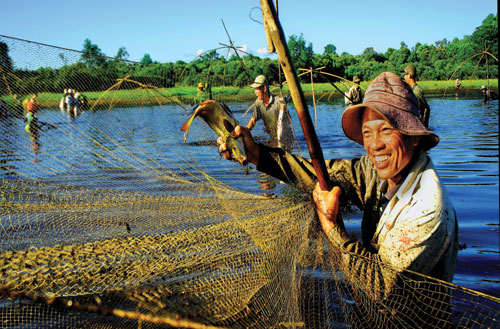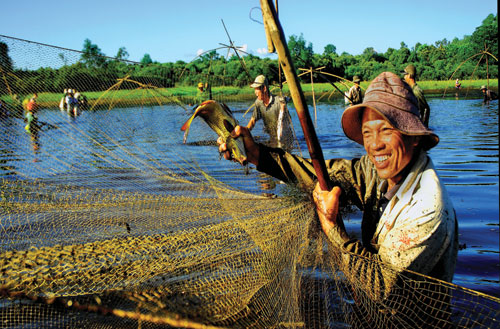(No.3, Vol.7,Jun-Jul 2017 Vietnam Heritage Magazine)
Hundreds of people with all kinds of traditional fish-catching tools rush down to a lagoon to hunt for fish under the boisterous cheering of thousands of others on the banks. Every now and then, a joyful shout announces a catch, expressing exultation and soliciting the crowd to join the fun.
That is the atmosphere of the fish-catching festival, also called ‘Let out the water to catch the fish’, which takes place around a 20ha lagoon within a 65ha primeval forest at Tra Loc Village, Hai Xuan Commune, Hai Lang District of Quang Tri Province.
Quang Tri is a northern province of Mid-Vietnam, made famous as the demilitarized zone (17th latitude) during the Vietnam War.
The annual activity, conducted every year for centuries, has no fixed date but usually takes place after the summer harvest, around the end of the 6th lunar month.
Farmers in the commune jointly organize the festival to celebrate a good harvest, pray for future good crops, and
at the same time have fun and clean
the lagoon.
The fish-catching fest is one of the best childhood memories of the people of Tra Loc, and of Hai Lang District in general. On this day, even those who now live far away also remember to come home to join the fun.
Taking part in the festival are people of all ages from all walks of life. The caught fish are normally given as a present to friends and relatives, or sold cheaply to tourists just for fun, and as a token of luck.

The 65ha forest surrounding Tra Loc Lagoon is an extremely important ‘green lung’ in the middle of an endless white sand desert, preserving valuable botanical species of sandy ecosystems. That’s why the forest, full of wildlife including weasels, squirrels, and all kinds of birds has been cherished and protected by local people for centuries. In 2006, the local government turned Tra Loc Forest and Lagoon into an ecotourism zone.
The tourist destination is about 6km to the southeast of Quang Tri city. Visitors can enjoy lotus blossoms in the pond and Tra Loc local food, and learn about a forest ecosystem in the midst of a desert.

